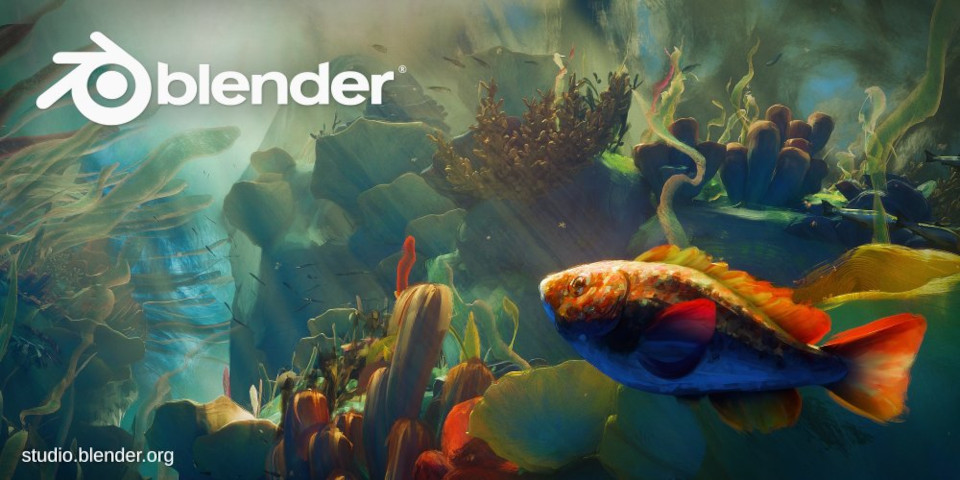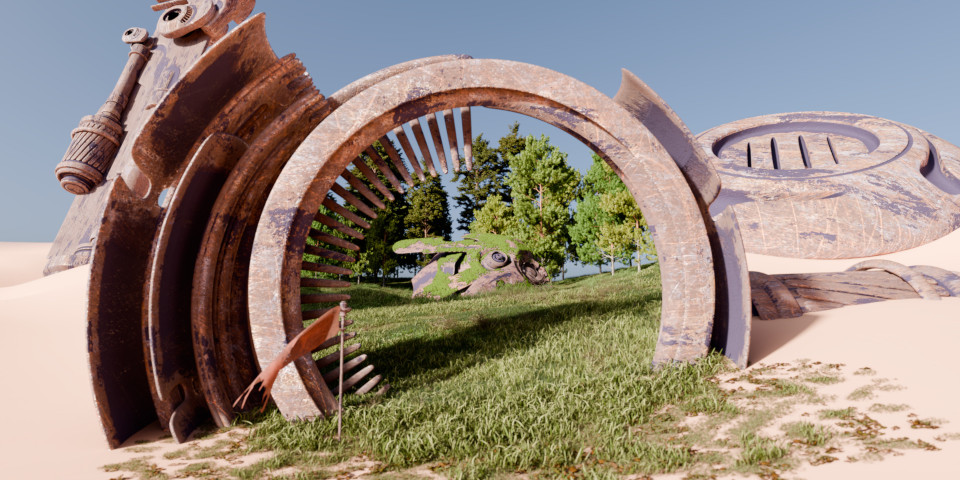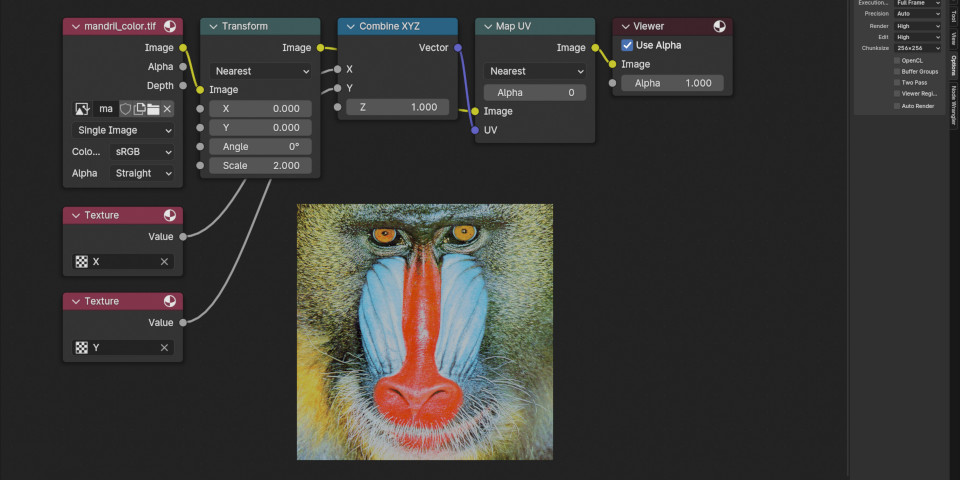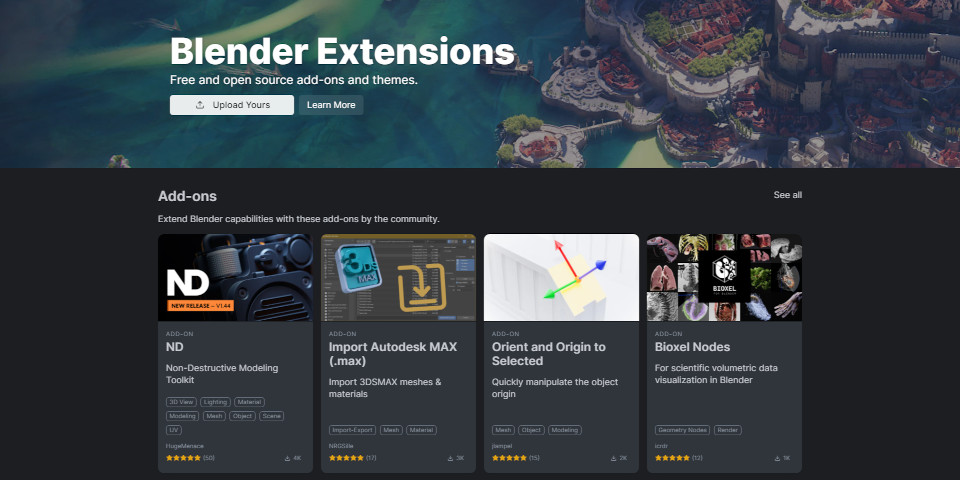5 key features in Blender 4.2

Main image: Blender 4.2’s promotional art, created by the Blender Studio.
The Blender Foundation has released Blender 4.2, the latest version of the open-source 3D software for artists working in VFX, animation, game development and visualization.
As well as being the latest Long-Term Stability release, the update features the long-awaited overhaul of Blender’s real-time render engine, codenamed ‘Eevee Next’.
Below, we’ve picked out five of the key changes, from Eevee Next itself to new sculpting tools, GPU-accelerated compositing and the new Extensions platform.
At the end of the story, you can find a summary of the updates to Blender’s other key toolsets, including 3D modeling, character rigging, animation and the Video Sequencer.
Animator Remington ‘SouthernShotty‘s run-down of the key features in Eevee Next. The long-awaited overhaul improves the quality and stability of Blender’s real-time renderer.
1. Eevee Next: better, more stable real-time rendering
The biggest change in Blender 4.2 is undoubtedly Eevee Next: the long-awaited overhaul of Eevee, Blender’s real-time render engine.
Originally scheduled for 2023, the work improves the visual quality and stability of Eevee’s output, bringing it closer to that of Cycles, Blender’s production render engine.
Big changes include a new Global Illumination system using screen-space ray tracing, real-time displacement, viewport motion blur, and support for unlimited lights in scene.
The work also improves the rendering of shadows, world volumes, and depth of field.
We did a story on the project last week, so check it out for details all of the changes in Eevee Next – and how to convert scenes created in older versions of Blender to work with it: as a major structural change to Eevee, the update isn’t backwards-compatible.

Cycles’ new Ray Portal BSDF transports light rays to a new position in a scene, making it possible to create non-physically based effects without compositing
2. Cycles: Ray Portals enable cool new rendering tricks
Cycles, Blender’s production renderer, gets a new Ray Portal BSDF, which transports light rays from one position to another in a scene.
It opens up a number of production rendering tricks, particularly for VFX, making it possible to create non-physically realistic phenomena like the portal shown above.
However, it can also be used for architectural visualization and general CG work: for example, for windows opening onto an interior space, or a camera feed on a monitor.
Users can specify the new start position and direction for the light rays passing through the portal, and tint the rays after they have passed through it.
The implementation supports AOVs, for better control of reflections and refractions.
Blender can now trim geometry along lines and poly lines as well as box and lasso selections, providing quick ways to cut polygonal shapes while sculpting.
3. Digital sculpting: new tools quickly cut polygonal shapes
Blender’s digital sculpting toolset gets eight new tools, with the existing Trim, Face Set, Mask and Hide tools getting new Line and Polyline counterparts.
The new tools – previously only available for Box and Lasso selections – provide a quick way to cut polygonal shapes, as shown in the video above.
In addition, the Trim tools can now use Fast or – slower, but more accurate – Exact solvers, and there is a new option to grow or shrink the visible part of a mesh iteratively.

Blender’s built-in compositor got a lot faster in Blender 4.2, with GPU acceleration enabled by default, and the CPU backend also now “several times faster” than before.
4. Compositor: GPU acceleration speeds up compositing of final renders
Blender’s built-in Compositor gets a lot faster in Blender 4.2, with GPU acceleration now available by default for final renders, rather than as an experimental feature.
In addition, the existing CPU backend has been rewritten to improve performance, “often making it several times faster than before”.
The CPU and GPU backends should give the same results, with “minimal differences” between devices.
In order to make GPU acceleration possible, the update removes some options when compositing, and means that some changes are no longer non-destructive.
Again, the changes are compatibility-breaking: you can find details in the release notes.

The new Blender Extensions library provides an online, community-approved repository of free, open-source extensions for the software.
5. Extensions: new official online library of Blender add-ons
The final key change in Blender 4.2 is not to the software itself, but to the bonus tools available for it.
Launched in beta in May, the new Extensions Platform provides an online library of ‘officially approved’ add-ons to the software.
In order to be listed, an add-on must be free and open-source – it needs to have a GPL-compliant license – although there are ways to link them to commercial plugins.
In addition, extensions must make it explicit when they require access to the internet, or to the user’s file system.
To be included on the Extensions platform, add-ons have to go through a public review and approval process.
At the time of writing, over 170 Extensions are available online, with dozens more waiting in the approval queue.
Extensions can be installed and updated directly within Blender via the new Extensions section of the user Preferences, which replaces the old Add-ons section.
The Geometry Nodes system’s new Matrix Socket type makes it possible to set up complex geometry operations, like stacking the pizza boxes in this animation.
Other changes: a quick summary of what else is new in the core toolsets
The user interface gets a lot of small but useful improvements, to UI scaling, font rendering, and the Status Bar, 3D viewport, node editor and Outliner.
Coders get an update to the Text Editor, making it possible to drag and drop strings and URLs, and adding support for GLSL syntax highlighting.
The updates to the 3D modeling tools are largely quality-of-life improvements, including the option to pin modifiers to the bottom of the stack.
Geometry Nodes get a new Matrix Socket type that “lays the ground work for the future of Geometry Nodes with advanced custom geometry operations”.
There are also workflow and performance updates to existing nodes, with the Sample UV Surface node now “10-20x faster when used on large meshes”.
The character rigging toolset gets some useful workflow features, including the option to specify a wire width for custom bone shapes.
Bones are now active – that is, editable in the Outliner – even if invisible, and subdividing a bone now names the new bones in sequential order.
The animation tools get a new Frame Scene Range option in all of the key animation editors, which zooms the horizontal view to match the scene range.
Other changes include a new Generated key type in the Dope Sheet, indicating that a key was generated by an add-on; and better performance in the Graph Editor.
There aren’t many changes to simulation this time round, but fluid domains now have liquid meshing enabled by default, so that they are visible in renders.
As well as the new Ray Portal BSDF, the Cycles renderer gets support for physically accurate thin film interference effects in the Principled BSDF.
Cycles also now supports blue noise dithered sampling, improving the visual quality of interactive viewport renders, and those with low sample counts.
For color management, Blender now supports Khronos PBR Neutral tonemapping, intended for ecommerce and product visualization.
The Video Sequencer gets quality-of-life improvements, including a visual overhaul of timeline strips, particularly text strips.
The file format exporters can be associated with Collections, streamlining the process of exporting the same asset repeatedly: for example, when iterating on a design.
There are also updates to the individual exporters, particularly USD, Alembic and glTF, but Collada (.dae) is now considered a legacy format, and is due for removal.
System requirements
Blender 4.2 is available for Windows 8.1+, macOS 11.2+ and glibc 2.28+ Linux. It now requires a SSE4.2-compatible CPU: any AMD or Intel CPU from the past 10 years.
The update is the latest Long-Term Support (LTS) release, and will receive critical fixes for two years. It’s a free download.
See the Blender Foundation’s overview of the new features in Blender 4.2
Read the Blender 4.2 release notes
Have your say on this story by following CG Channel on Facebook, Instagram and X (formerly Twitter). As well as being able to comment on stories, followers of our social media accounts can see videos we don’t post on the site itself, including making-ofs for the latest VFX movies, animations, games cinematics and motion graphics projects.
